HONDA FIT 2014 3.G Repair Manual
Manufacturer: HONDA, Model Year: 2014, Model line: FIT, Model: HONDA FIT 2014 3.GPages: 289, PDF Size: 6.97 MB
Page 61 of 289
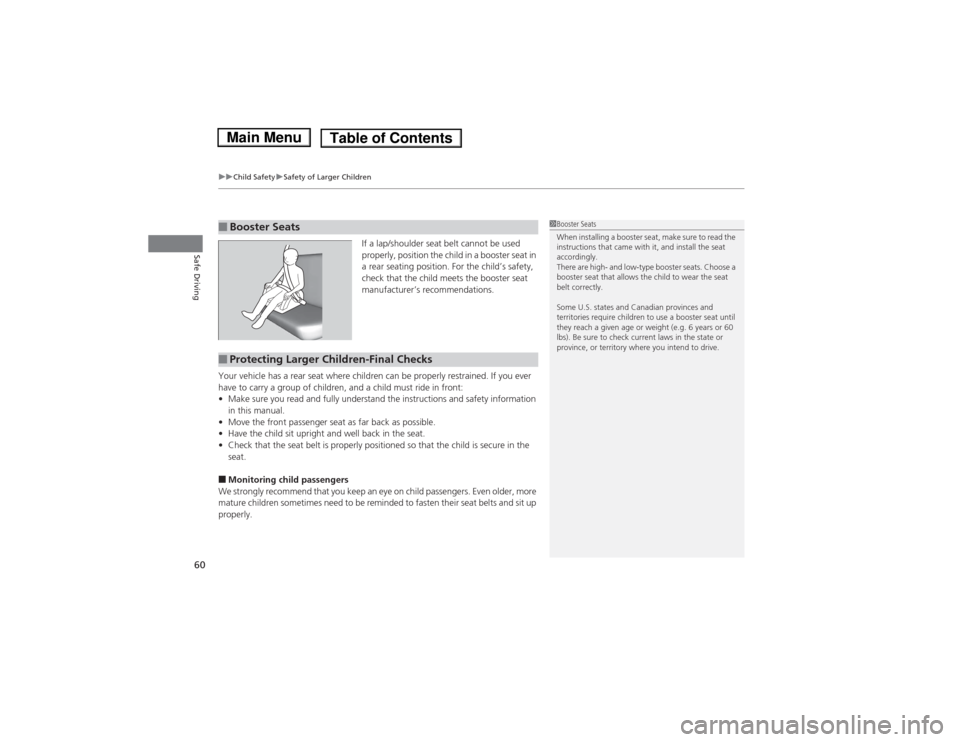
uuChild SafetyuSafety of Larger Children
60Safe Driving
If a lap/shoulder seat belt cannot be used
properly, position the child in a booster seat in
a rear seating position. For the child’s safety,
check that the child meets the booster seat
manufacturer’s recommendations.
Your vehicle has a rear seat where children can be properly restrained. If you ever
have to carry a group of children, and a child must ride in front:
•Make sure you read and fully understand the instructions and safety information
in this manual.
•Move the front passenger seat as far back as possible.
•Have the child sit upright and well back in the seat.
•Check that the seat belt is properly positioned so that the child is secure in the
seat.
■Monitoring child passengers
We strongly recommend that you keep an eye on child passengers. Even older, more
mature children sometimes need to be reminded to fasten their seat belts and sit up
properly.■Booster Seats
1Booster Seats
When installing a booster seat, make sure to read the
instructions that came with it, and install the seat
accordingly.
There are high- and low-type booster seats. Choose a
booster seat that allows the child to wear the seat
belt correctly.
Some U.S. states and Canadian provinces and
territories require children to use a booster seat until
they reach a given age or weight (e.g. 6 years or 60
lbs). Be sure to check current laws in the state or
province, or territory where you intend to drive.
■Protecting Larger Children-Final Checks
Page 62 of 289
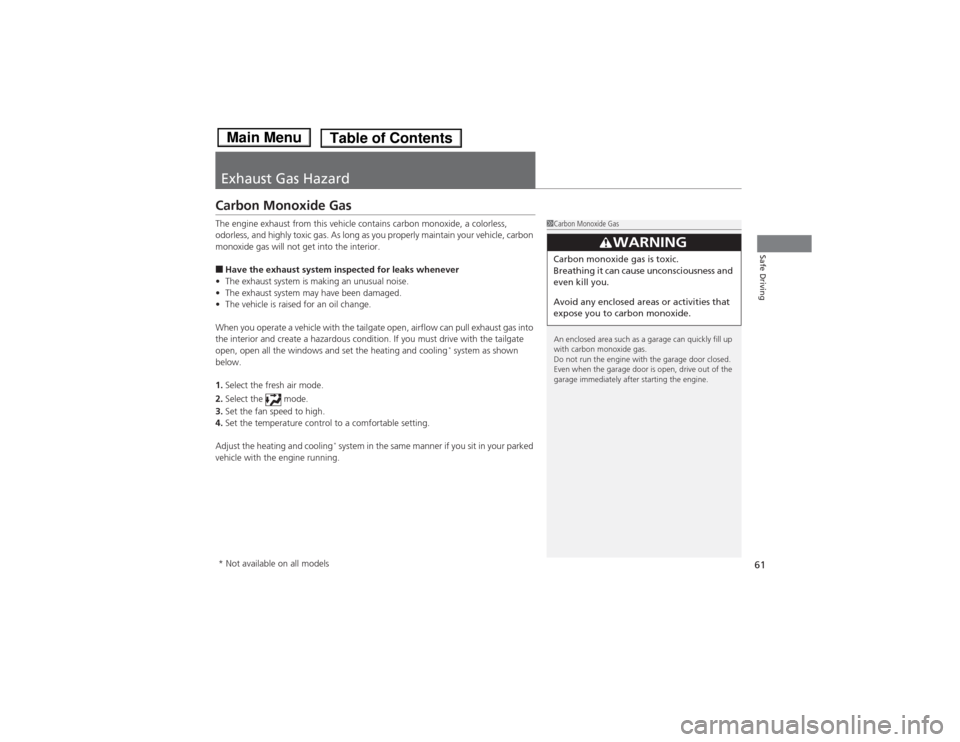
61Safe Driving
Exhaust Gas HazardCarbon Monoxide GasThe engine exhaust from this vehicle contains carbon monoxide, a colorless,
odorless, and highly toxic gas. As long as you properly maintain your vehicle, carbon
monoxide gas will not get into the interior.■Have the exhaust system inspected for leaks whenever
•The exhaust system is making an unusual noise.
•The exhaust system may have been damaged.
•The vehicle is raised for an oil change.
When you operate a vehicle with the tailgate open, airflow can pull exhaust gas into
the interior and create a hazardous condition. If you must drive with the tailgate
open, open all the windows and set the heating and cooling
* system as shown
below.
1.Select the fresh air mode.
2.Select the mode.
3.Set the fan speed to high.
4.Set the temperature control to a comfortable setting.
Adjust the heating and cooling
* system in the same manner if you sit in your parked
vehicle with the engine running.
1Carbon Monoxide Gas
An enclosed area such as a garage can quickly fill up
with carbon monoxide gas.
Do not run the engine with the garage door closed.
Even when the garage door is open, drive out of the
garage immediately after starting the engine.
3
WARNING
Carbon monoxide gas is toxic.
Breathing it can cause unconsciousness and
even kill you.
Avoid any enclosed areas or activities that
expose you to carbon monoxide.
* Not available on all models
Page 63 of 289
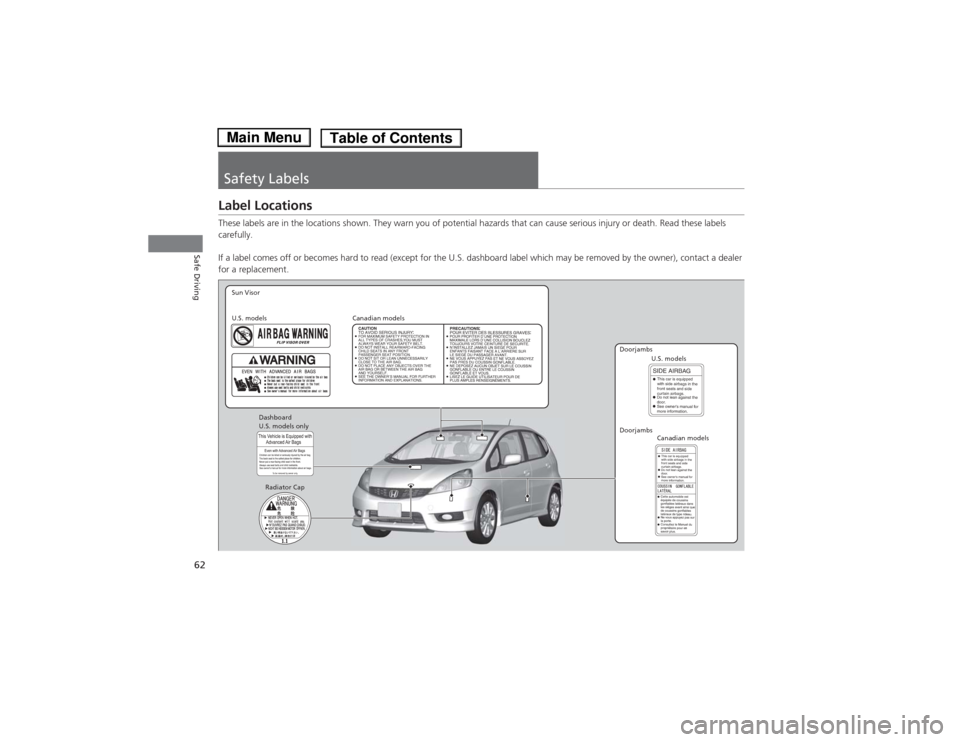
62Safe Driving
Safety LabelsLabel LocationsThese labels are in the locations shown. They warn you of potential hazards that can cause serious injury or death. Read these labels
carefully.
If a label comes off or becomes hard to read (except for the U.S. dashboard label which may be removed by the owner), contact a dealer
for a replacement.
Sun Visor
U.S. models
Canadian models
Radiator CapDoorjambsU.S. models
U.S. models only Dashboard
Canadian models Doorjambs
Page 64 of 289
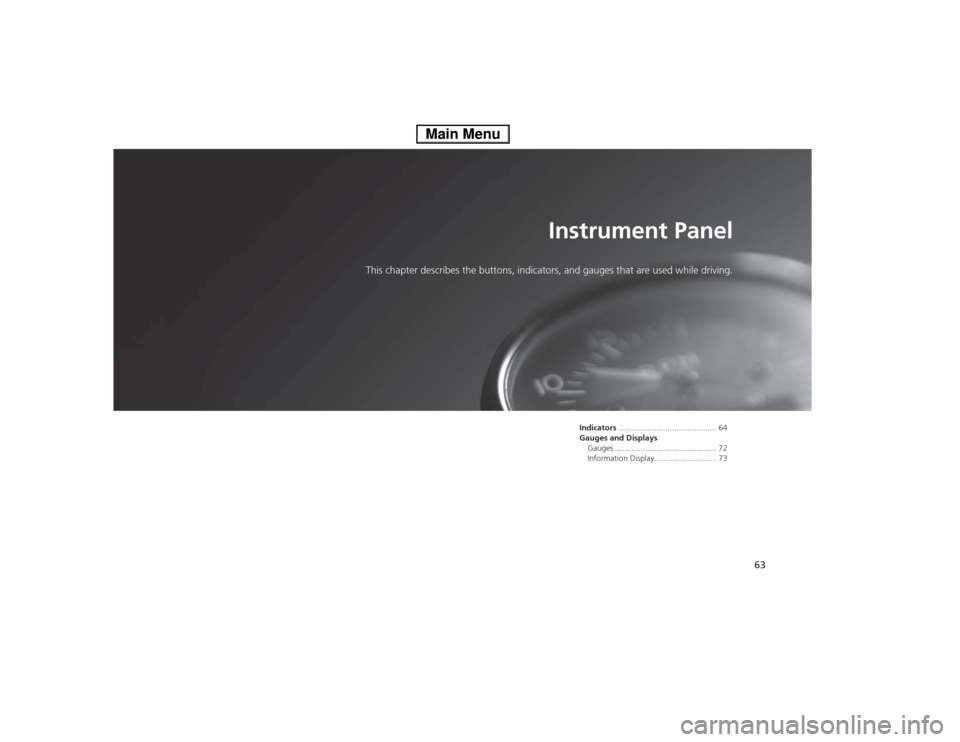
63
Instrument Panel
This chapter describes the buttons, indicators, and gauges that are used while driving.
Indicators............................................ 64
Gauges and Displays
Gauges .............................................. 72
Information Display............................ 73
Page 65 of 289
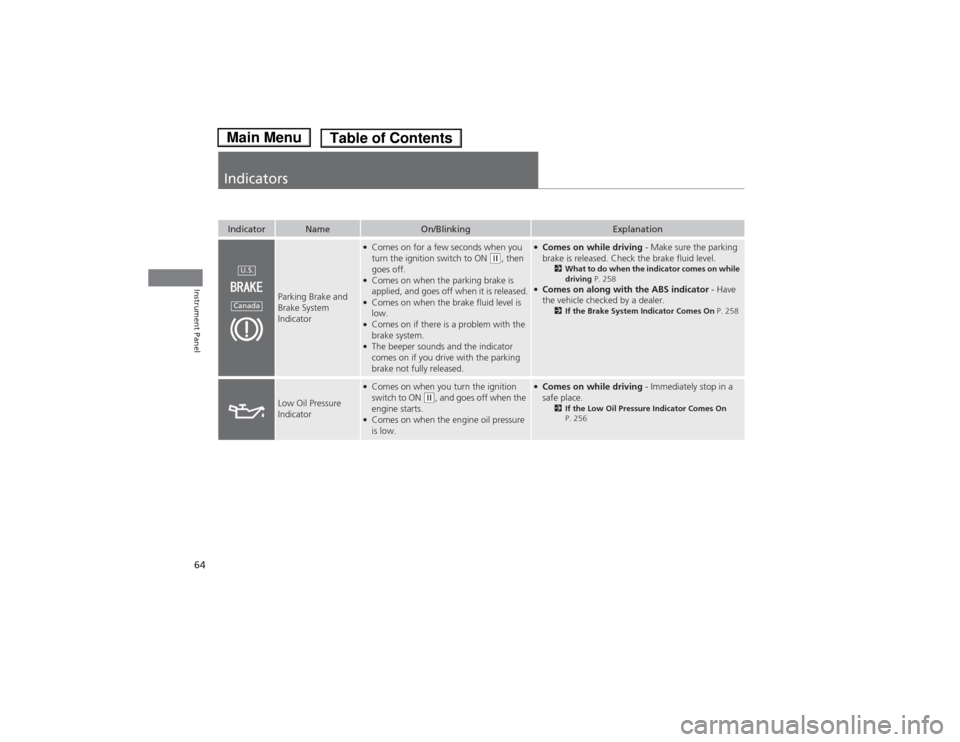
64Instrument Panel
IndicatorsIndicator
Name
On/Blinking
Explanation
Parking Brake and
Brake System
Indicator
●Comes on for a few seconds when you
turn the ignition switch to ON
(w, then
goes off.
●Comes on when the parking brake is
applied, and goes off when it is released.●Comes on when the brake fluid level is
low.●Comes on if there is a problem with the
brake system.●The beeper sounds and the indicator
comes on if you drive with the parking
brake not fully released.
●Comes on while driving - Make sure the parking
brake is released. Check the brake fluid level.
2What to do when the indicator comes on while
driving P. 258
●Comes on along with the ABS indicator - Have
the vehicle checked by a dealer.
2If the Brake System Indicator Comes On P. 258
Low Oil Pressure
Indicator
●Comes on when you turn the ignition
switch to ON
(w, and goes off when the
engine starts.
●Comes on when the engine oil pressure
is low.
●Comes on while driving - Immediately stop in a
safe place.
2If the Low Oil Pressure Indicator Comes On
P. 256
U.S.Canada
Page 66 of 289
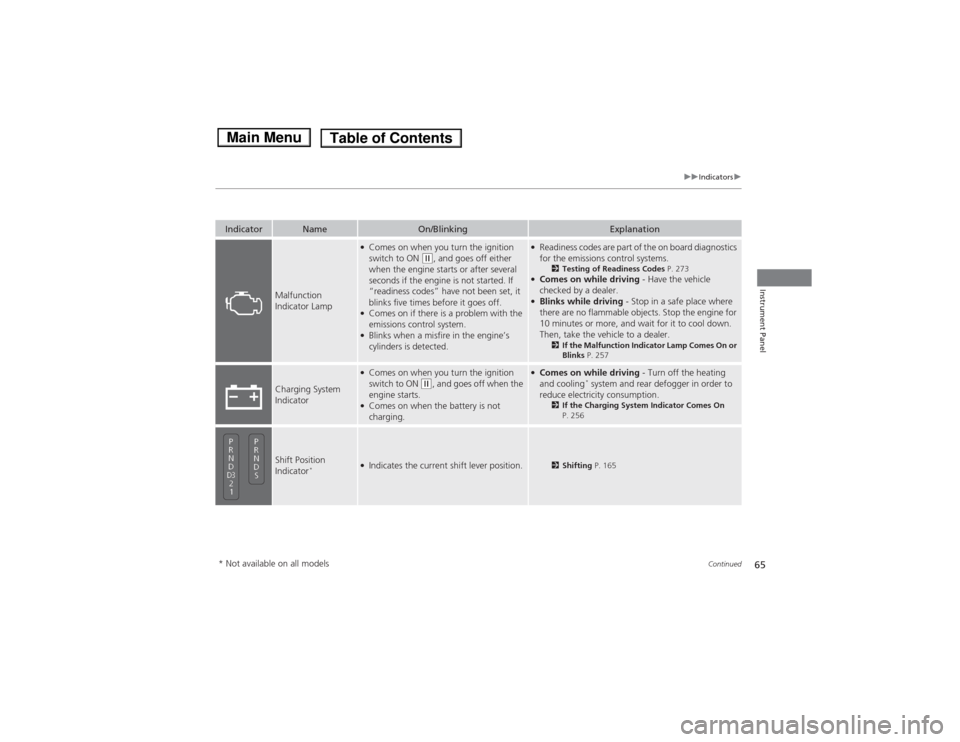
65
uuIndicatorsu
Continued
Instrument Panel
Indicator
Name
On/Blinking
Explanation
Malfunction
Indicator Lamp
●Comes on when you turn the ignition
switch to ON
(w, and goes off either
when the engine starts or after several
seconds if the engine is not started. If
“readiness codes” have not been set, it
blinks five times before it goes off.
●Comes on if there is a problem with the
emissions control system.●Blinks when a misfire in the engine’s
cylinders is detected.
●Readiness codes are part of the on board diagnostics
for the emissions control systems.
2Testing of Readiness Codes P. 273
●Comes on while driving - Have the vehicle
checked by a dealer.●Blinks while driving - Stop in a safe place where
there are no flammable objects. Stop the engine for
10 minutes or more, and wait for it to cool down.
Then, take the vehicle to a dealer.
2If the Malfunction Indicator Lamp Comes On or
Blinks P. 257
Charging System
Indicator
●Comes on when you turn the ignition
switch to ON
(w, and goes off when the
engine starts.
●Comes on when the battery is not
charging.
●Comes on while driving - Turn off the heating
and cooling
* system and rear defogger in order to
reduce electricity consumption.
2If the Charging System Indicator Comes On
P. 256
Shift Position
Indicator
*
●Indicates the current shift lever position.
2Shifting P. 165
* Not available on all models
Page 67 of 289
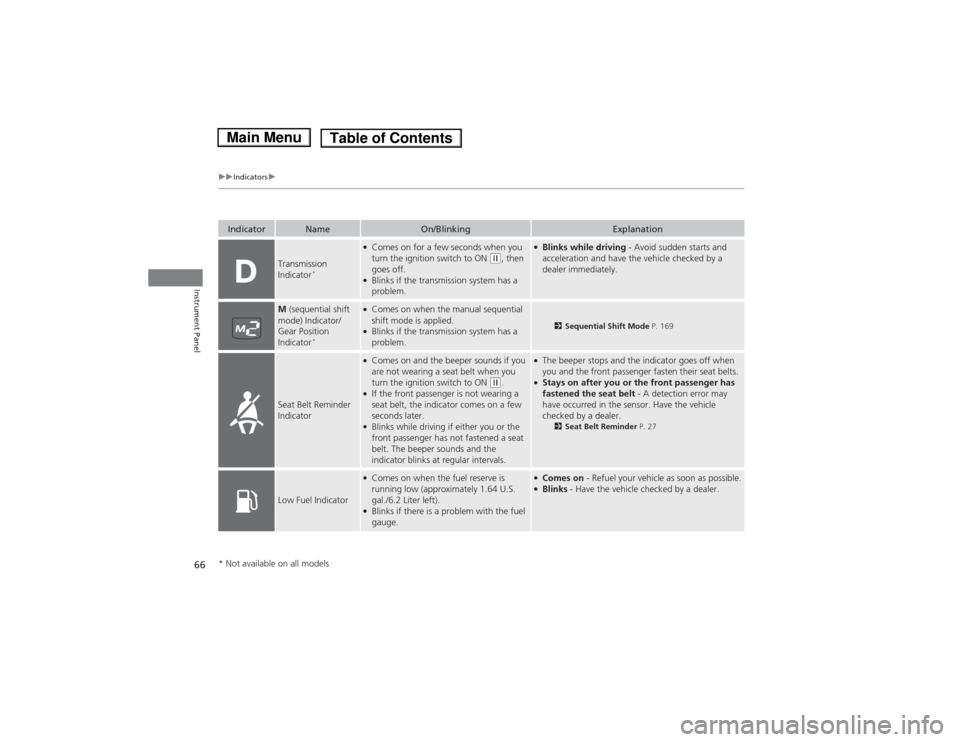
66
uuIndicatorsu
Instrument Panel
Indicator
Name
On/Blinking
Explanation
Transmission
Indicator
*
●Comes on for a few seconds when you
turn the ignition switch to ON
(w, then
goes off.
●Blinks if the transmission system has a
problem.
●Blinks while driving - Avoid sudden starts and
acceleration and have the vehicle checked by a
dealer immediately.
M (sequential shift
mode) Indicator/
Gear Position
Indicator
*
●Comes on when the manual sequential
shift mode is applied.●Blinks if the transmission system has a
problem.
2Sequential Shift Mode P. 169
Seat Belt Reminder
Indicator
●Comes on and the beeper sounds if you
are not wearing a seat belt when you
turn the ignition switch to ON
(w.
●If the front passenger is not wearing a
seat belt, the indicator comes on a few
seconds later.●Blinks while driving if either you or the
front passenger has not fastened a seat
belt. The beeper sounds and the
indicator blinks at regular intervals.
●The beeper stops and the indicator goes off when
you and the front passenger fasten their seat belts.●Stays on after you or the front passenger has
fastened the seat belt - A detection error may
have occurred in the sensor. Have the vehicle
checked by a dealer.
2Seat Belt Reminder P. 27
Low Fuel Indicator
●Comes on when the fuel reserve is
running low (approximately 1.64 U.S.
gal./6.2 Liter left).●Blinks if there is a problem with the fuel
gauge.
●Comes on - Refuel your vehicle as soon as possible.●Blinks - Have the vehicle checked by a dealer.
* Not available on all models
Page 68 of 289
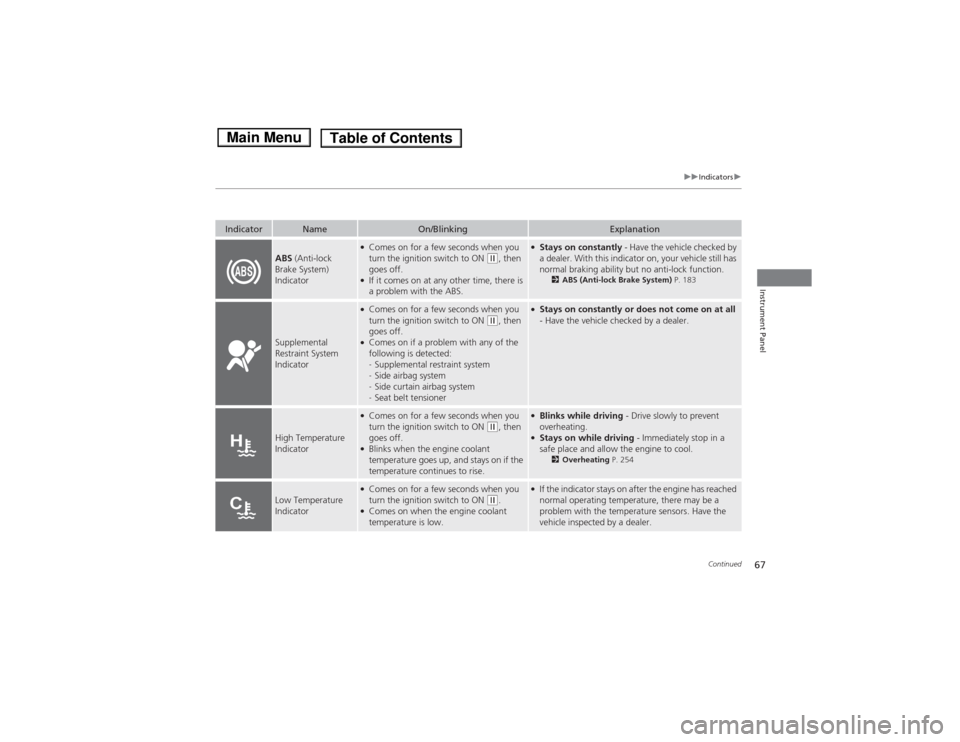
67
uuIndicatorsu
Continued
Instrument Panel
Indicator
Name
On/Blinking
Explanation
ABS (Anti-lock
Brake System)
Indicator
●Comes on for a few seconds when you
turn the ignition switch to ON
(w, then
goes off.
●If it comes on at any other time, there is
a problem with the ABS.
●Stays on constantly - Have the vehicle checked by
a dealer. With this indicator on, your vehicle still has
normal braking ability but no anti-lock function.
2ABS (Anti-lock Brake System) P. 183
Supplemental
Restraint System
Indicator
●Comes on for a few seconds when you
turn the ignition switch to ON
(w, then
goes off.
●Comes on if a problem with any of the
following is detected:
-Supplemental restraint system
-Side airbag system
-Side curtain airbag system
-Seat belt tensioner
●Stays on constantly or does not come on at all
- Have the vehicle checked by a dealer.
High Temperature
Indicator
●Comes on for a few seconds when you
turn the ignition switch to ON
(w, then
goes off.
●Blinks when the engine coolant
temperature goes up, and stays on if the
temperature continues to rise.
●Blinks while driving - Drive slowly to prevent
overheating.●Stays on while driving - Immediately stop in a
safe place and allow the engine to cool.
2Overheating P. 254
Low Temperature
Indicator
●Comes on for a few seconds when you
turn the ignition switch to ON
(w.
●Comes on when the engine coolant
temperature is low.
●If the indicator stays on after the engine has reached
normal operating temperature, there may be a
problem with the temperature sensors. Have the
vehicle inspected by a dealer.
Page 69 of 289
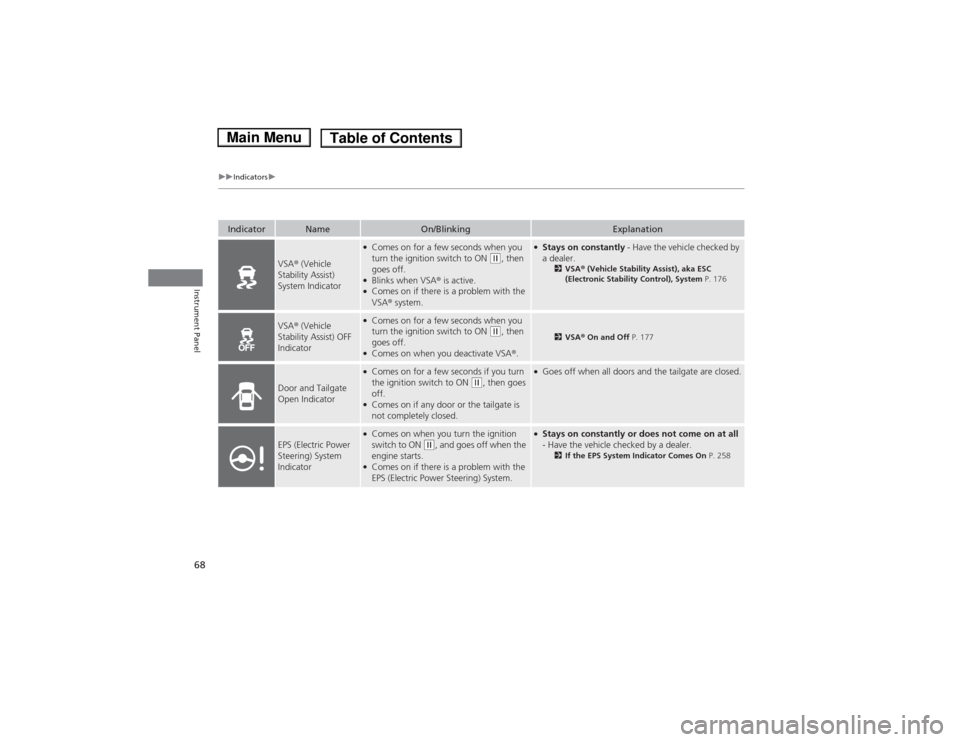
68
uuIndicatorsu
Instrument Panel
Indicator
Name
On/Blinking
Explanation
VSA® (Vehicle
Stability Assist)
System Indicator
●Comes on for a few seconds when you
turn the ignition switch to ON
(w, then
goes off.
●Blinks when VSA® is active.●Comes on if there is a problem with the
VSA® system.
●Stays on constantly - Have the vehicle checked by
a dealer.
2VSA® (Vehicle Stability Assist), aka ESC
(Electronic Stability Control), System P. 176
VSA® (Vehicle
Stability Assist) OFF
Indicator
●Comes on for a few seconds when you
turn the ignition switch to ON
(w, then
goes off.
●Comes on when you deactivate VSA®.
2VSA® On and Off P. 177
Door and Tailgate
Open Indicator
●Comes on for a few seconds if you turn
the ignition switch to ON
(w, then goes
off.
●Comes on if any door or the tailgate is
not completely closed.
●Goes off when all doors and the tailgate are closed.
EPS (Electric Power
Steering) System
Indicator
●Comes on when you turn the ignition
switch to ON
(w, and goes off when the
engine starts.
●Comes on if there is a problem with the
EPS (Electric Power Steering) System.
●Stays on constantly or does not come on at all
- Have the vehicle checked by a dealer.
2If the EPS System Indicator Comes On P. 258
Page 70 of 289
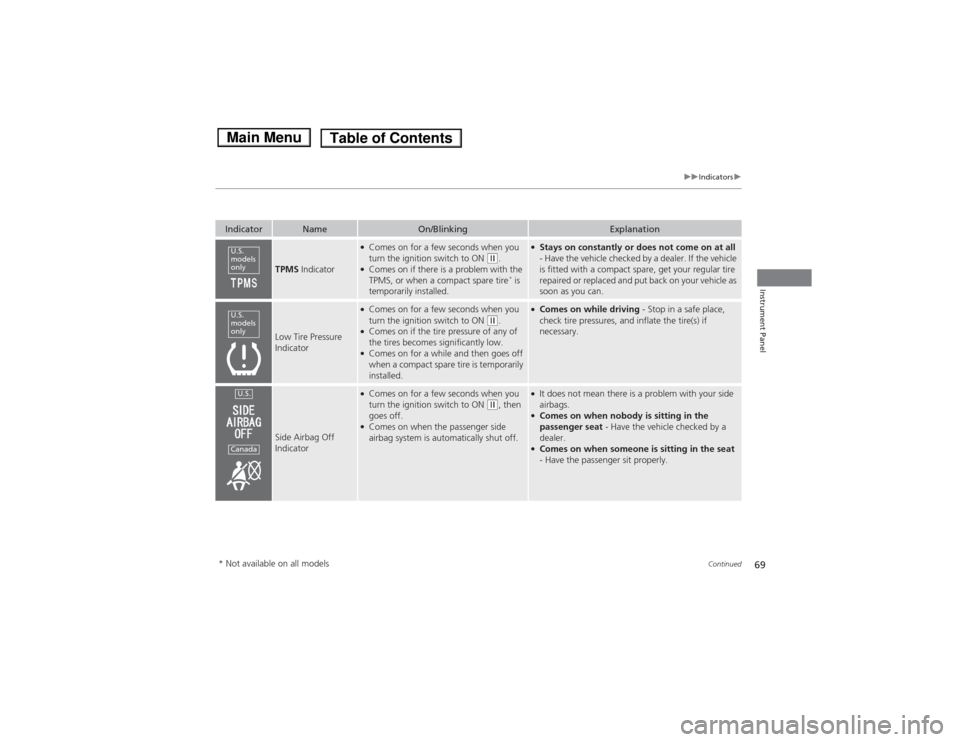
69
uuIndicatorsu
Continued
Instrument Panel
Indicator
Name
On/Blinking
Explanation
TPMS Indicator
●Comes on for a few seconds when you
turn the ignition switch to ON
(w.
●Comes on if there is a problem with the
TPMS, or when a compact spare tire
* is
temporarily installed.
●Stays on constantly or does not come on at all
- Have the vehicle checked by a dealer. If the vehicle
is fitted with a compact spare, get your regular tire
repaired or replaced and put back on your vehicle as
soon as you can.
Low Tire Pressure
Indicator
●Comes on for a few seconds when you
turn the ignition switch to ON
(w.
●Comes on if the tire pressure of any of
the tires becomes significantly low.●Comes on for a while and then goes off
when a compact spare tire is temporarily
installed.
●Comes on while driving - Stop in a safe place,
check tire pressures, and inflate the tire(s) if
necessary.
Side Airbag Off
Indicator
●Comes on for a few seconds when you
turn the ignition switch to ON
(w, then
goes off.
●Comes on when the passenger side
airbag system is automatically shut off.
●It does not mean there is a problem with your side
airbags.●Comes on when nobody is sitting in the
passenger seat - Have the vehicle checked by a
dealer.●Comes on when someone is sitting in the seat
- Have the passenger sit properly.
U.S.
models
onlyU.S.
models
onlyU.S.Canada
* Not available on all models